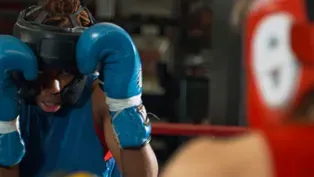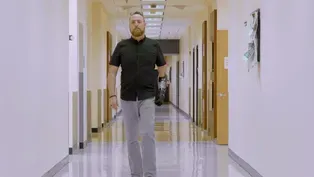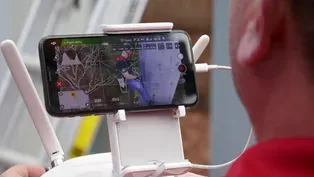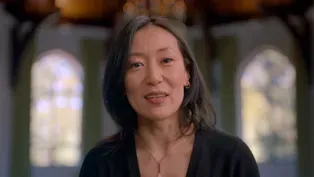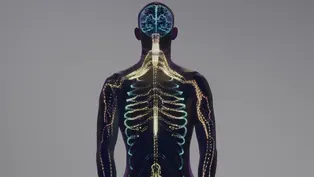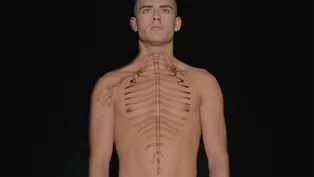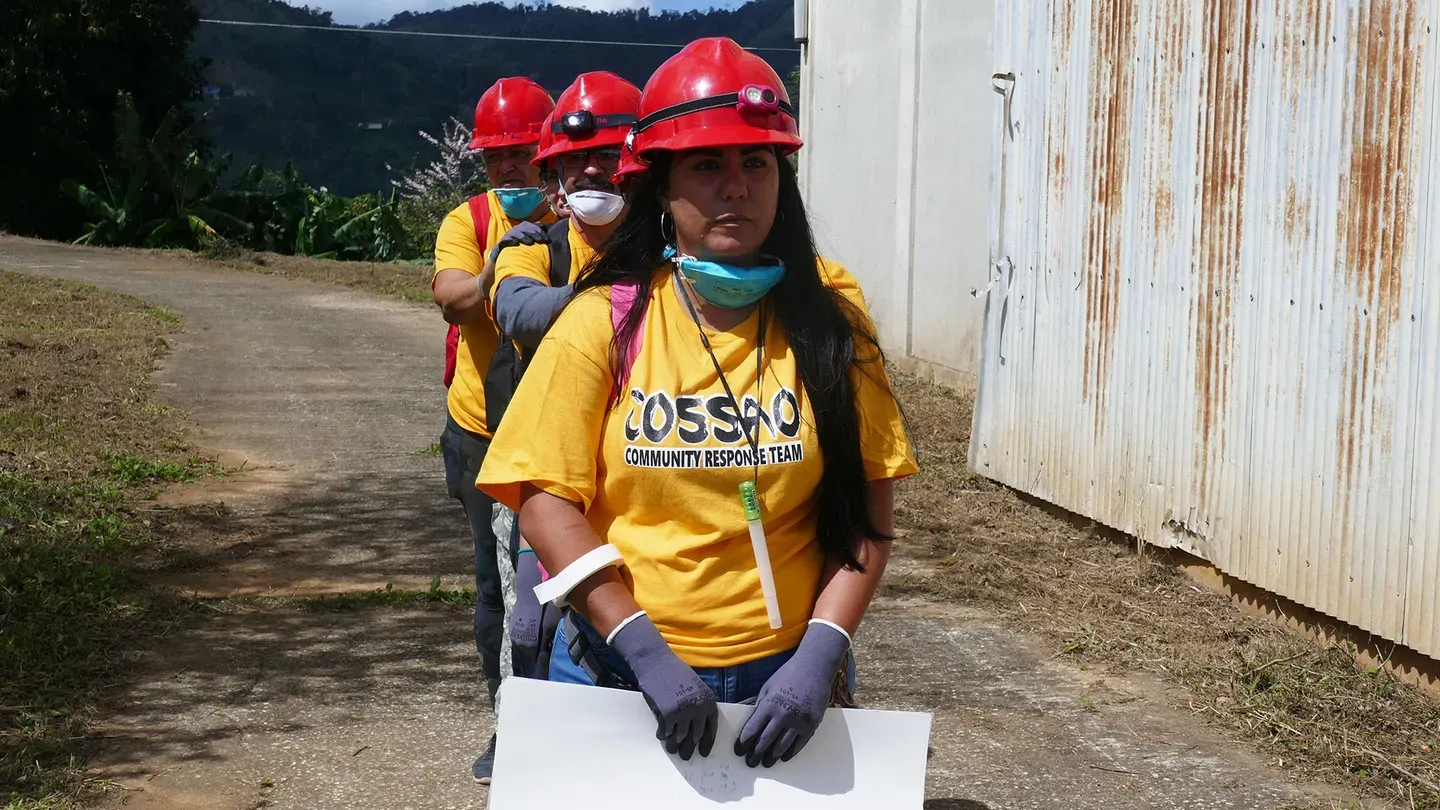

React
Episode 6 | 52m 30sVideo has Audio Description, Closed Captions
See how the technology of the brain and nervous system shape our experience of the world.
Through the lens of a boxer, a first responder, a cell tower climber and a man with a bionic limb, go deep into the universe of the most powerful machine on earth: the human brain and the vast nervous system it controls.
See all videos with Audio DescriptionADProblems with Closed Captions? Closed Captioning Feedback
Problems with Closed Captions? Closed Captioning Feedback

React
Episode 6 | 52m 30sVideo has Audio Description, Closed Captions
Through the lens of a boxer, a first responder, a cell tower climber and a man with a bionic limb, go deep into the universe of the most powerful machine on earth: the human brain and the vast nervous system it controls.
See all videos with Audio DescriptionADProblems with Closed Captions? Closed Captioning Feedback
How to Watch Human: The World Within
Human: The World Within is available to stream on pbs.org and the free PBS App, available on iPhone, Apple TV, Android TV, Android smartphones, Amazon Fire TV, Amazon Fire Tablet, Roku, Samsung Smart TV, and Vizio.
Buy Now
Providing Support for PBS.org
Learn Moreabout PBS online sponsorship-The human body is full of systems.
Some protect us... others nourish us or keep us moving... ♪♪ But there's one system that controls all the others... and it might be the one that truly makes you you... the nervous system.
♪♪ To put it simply, it perceives the world and tells you how to react to it.
Should you jump... run...eat... shiver...cry?
It makes all of those split-second decisions.
And it also creates emotions, ideas, and memories.
Altogether, it's one incredible machine that never stops reacting.
We're about to take a trip through an astonishing universe that lives right inside our bodies to uncover the systems that make us human.
♪♪ ♪♪ ♪♪ It sits inside the skull in total darkness... three pounds of grayish-white matter, the consistency of tofu.
It's more than 80% water with a little fat and a little protein.
♪♪ The brain.
Mission control of the human body... and the nervous system.
It's in charge of how we react to everything.
The brain is pure processing power, connected to a giant network of nerves and fibers that work in perfect synergy to turn data to action.
♪♪ Especially when life comes at you fast.
♪♪ -My name is Iman James.
I'm 29 years old, and I am an amateur boxer.
♪♪ ♪♪ -There are few sports that challenge your nervous system quite like boxing.
I mean, think about it.
In a fraction of a second, you got to process your opponent's move and react to it.
If you're not quick enough... you definitely feel it.
♪♪ But as furious as the action seems outside the body... an even more high-speed dance is occurring every moment on the inside.
♪♪ See, the nervous system is made up of highly specialized cells called neurons that send signals at hundreds of miles per hour.
-Neurons are the building blocks of the brain.
They are the parts that actually make you think... decide... imagine... see things or listen to things.
-[ Laughs ] -Neurons don't look like other cells.
Most cells are compact and round, but neurons, they look more like the roots of a flower with strands that branch out in every direction to connect to other neurons so that they can pass information back and forth.
There are 100 billion of them inside the brain, with millions more snaked throughout the body.
But what really makes them ingenious is that we can train these cells to do almost anything... and in the process, completely transform who we are.
♪♪ -Everyone can box.
You have to kind of push aside that self-doubt at some point, and once you accept that, you're like, "Oh, what I become is entirely up to me."
I am a teacher.
I teach middle school and high school math and health.
I became a teacher because I wanted to fulfill some sort of need in kids' lives to push them to be better.
I want my students to know they can do anything they want.
♪♪ A lot of people make the assumption that boxers come from, like, the hard knocks of life, that you have to be really rough, maybe even angry.
I never got into a single physical fight as a kid.
I started boxing to lose weight in college.
I just totally fell in love with the sport.
Anytime I was hitting something, I was like, "Oh!"
It was like endorphins all the time.
That's what makes boxing so intoxicating.
-Being a boxer isn't just about landing a punch.
It requires extreme mental agility.
And it all begins with sight.
♪♪ Everything we see starts as one thing: light.
When light particles enter the eye through that black hole at the center... they make their way to the back wall of the eyeball where they hit a thin piece of tissue... called the retina.
♪♪ The retina has millions of tiny receptors called rods and cones, which absorb the light particles coming in and send them back as something the brain can use: electricity.
These electrical signals travel to the optic nerve and onto the brain.
Impulses are kind of like Morse Code, and the brain takes that code and turns it into your reality.
-The amount of compression of data that happens between the retina and the optic nerve is the biggest amount of data compression that we've really witnessed in biology, and it's right here in our eyes.
-Every second, the eye transmits 10 million pulses to the brain at a speed of 270 miles per hour.
Then just as quickly, the brain has to react.
So a boxer sees a punch coming.
That info zips to the brain, then a conversation happens.
Should I duck or knock her out?
Like any decision, it's about weighing the options.
Maybe the boxer has a memory of being punched before... or maybe this is a brand-new experience.
♪♪ Either way, in an instant the brain makes a call, and a host of neurons begin firing.
♪♪ -Neurons in the brain communicate through electricity and through releasing chemicals.
At the end of a cell is a synapse and it's the small space between neurons.
So the first neuron releases a chemical substance that's detected by the second neuron which then continues that electrical activity.
You can say it's a mixture of a lighting storm and a chemical storm.
-Our brain sends new impulses across our body triggering just the right muscles... to react.
♪♪ ♪♪ -The first time I sparred, I almost, I swear to God, died.
We did three 2-minute rounds.
It was the longest six minutes of my life... and it was hard and I got hit a lot, but I knew what I needed to work on, and that's what this sport is about.
♪♪ -One of the most remarkable things about the brain is how adaptable it is... with a little practice.
♪♪ -So a boxer, like most athletes, carry out the same movements repeatedly over and over.
♪♪ And the more and more you do it, the brain learns, and it gets encoded into muscle memory.
-PJ has been my coach since 2015.
Hitting the pads with PJ does a lot to help me prepare.
Helps me to work on timing, on defense, on footwork, combinations.
What we're trying to get to is perfection.
Obviously that doesn't really exist, but if you're not striving for it, then what's the point?
-The more you practice something, the more somehow your brain changes.
This is called neuroplasticity.
♪♪ -This system is pretty flexible.
Every single neuron in the brain can form up to 10,000 connections with other neurons.
And those links change... based on the things that we do most.
When a boxer learns a new move... the pathway is temporary, forged by chemicals surrounding the neuron.
But as she practices... day in... day out... those chemical changes become structural.
Over time, neurons will actually change shape and shift their position.
And as the pathway gets more fixed... connections between different brain regions strengthen.
-Since I first started fighting, I've definitely gotten calmer in the ring.
Punches come to me and I'm not overreacting.
When I'm fighting, time disappears.
I don't even have to think, but instinctively I'm moving and evading those punches, and it takes no effort when the mind and body are one.
♪♪ -It's astonishing to me just how adaptable our brain can be.
By practicing things we want to get good at, we do get better.
We do lay down the neural frameworks to be able to improve ourselves at certain tasks.
That mechanism of transmitting those, what we call actual potentials, from one neuron to another is the basis of how information is transmitted in our body, is the basis of computation, and is the basis of memory in our minds.
♪♪ -A memory is just a group of neurons having a familiar conversation.
So as we learn a new skill, we're forming a stronger and stronger memory of how to accomplish that task.
Skills that require us to use our muscles... like sinking a basket, playing the piano, or tying a shoe, can be locked into our memories for a lifetime.
Hence the saying, "It's like riding a bike."
But other memories, like faces and names, can fade over time as we need them less.
Our neurons forget how to make those connections.
There is one way a memory tends to stick around... and that's when there's a strong emotion attached to it.
♪♪ In fact, emotions and the nervous system go hand in hand.
The nervous system is in charge not only of processing our emotions, but deciding how we react to them.
But sometimes, emotions are so strong that they overload the system... ♪♪ ...with life threatening consequences.
[ Birds chirping ] ♪♪ ♪♪ -[ Speaking Spanish ] -We are following the path of Hurricane Maria now battering Puerto Rico.
-The hurricane is doing incredible damage to a country that really is not in any shape to withstand it.
-In September 2017, a category 5 hurricane descended upon Puerto Rico.
Magaly Rodriguez lived with her two daughters on a remote stretch of the island.
She was about to live through two kinds of hell -- the storm itself, and fear shutting down her body.
♪♪ -[ Speaking Spanish ] -Fear is a very powerful protective mechanism for us as people.
It's an enormously powerful adaptation to helping us internalize a threat and then be able to respond to it hopefully before the threat catches up to us.
♪♪ -Inside the brain, you find one region that really controls the fear instinct.
It's an inch-long almond-shaped bulb called the amygdala.
When we're faced with a dangerous situation, the amygdala sounds an alarm... setting off a chain of events.
A cocktail of hormones courses through the body.
Pupils dilate to take in more light.
The heart begins pumping blood faster.
And that blood is rerouted from less essential organs to higher priority ones like leg muscles that can kick or run.
♪♪ That's why when you're scared, you get butterflies.
Blood flow to your stomach dramatically slows down.
♪♪ It's also why you get the chills, with less blood in the skin to keep you warm.
All of these changes are preparing you to react to the threat... ...by either standing your ground or running for your life.
-The fight or flight response is ancient.
In humans, it's similar to how it is in other organisms.
It's what happens when you are faced with a sudden danger or something that alarms you.
-But danger is usually more complex than just fight or flight.
And when you're staring at a crisis, fear, and how your brain interprets it, can quickly become the greatest threat.
-[ Speaking Spanish ] -Sometimes during extreme stress, the fear response takes total control of the mind and body.
We end up completely paralyzed by our own emotions.
It's a phenomenon known as the amygdala hijack.
The parts of the brain that use logic and reason shut down completely.
No signals can reach them.
The impulses go straight to the amygdala, which runs totally on instinct and emotion.
When this happens, you might experience an unwarranted outburst of anger or become frozen in fear.
-[ Speaking Spanish ] -Magaly's fear response left her powerless when her daughters needed her to be strong.
She was determined to never let that happen again.
-When fear goes too far, if fear becomes the dominant sensation that we experience as humans, that can prevent us from taking on new challenges and potentially growing.
♪♪ -But how our brains react is actually up to us.
We can learn to control fear by making it more familiar.
That's why now Magaly is training to become a first responder.
She's about to take part in a disaster rescue drill that will put her fear tolerance to the test... ♪♪ ...so she can learn to quiet her amygdala's alarm bells.
-We can train different parts of our brain to turn on and off.
There's a huge component of biofeedback, of thinking, of breathing that can really help us.
-[ Speaking Spanish ] -[ Moaning in distance ] -Blood... smoke... screams.
-[ Screaming in distance ] -All meant to flood the brain with stress.
But that's the whole point.
It's mental boot camp.
Just like how we can improve our muscles' speed and strength with practice... we can do the same with our emotions.
-When we expose ourselves in small, controlled doses to the things that make us stressed, we can build resistance.
Our anxiety tolerance goes up, and the amygdala can work to our advantage.
-The amygdala is a beautiful, beautiful structure because that's where a lot of memories, especially emotional memories are stored.
It stores not only negative, but also positive memories.
-If we can train our brains to remember how we handled the stressful situation, the amygdala will recall that stored memory in a future moment of fear... and allow logic and reason to stick around.
-Your nervous system actually has all the tools it needs to keep you calm during stressful situations... You just need to know how to activate them.
-We essentially have two branches of our autonomic nervous system, the sympathetic nervous system and the parasympathetic.
Now, sympathetic nervous system is our fight or flight response.
Too much of this stress response is not a good thing, and that's when we need a kick in our parasympathetic nervous system.
This is the part of your body that's going to help you basically do all the maintenance things such as digesting food.
Being able to activate your parasympathetic nervous system a little bit more is a good thing, and people can do this when they're in a stressful situation that might fire their sympathetic nervous system by taking a step back, calming their anxiety, calming their stress, taking a deep breath.
And trying to get a little bit more in tune to what the situation is.
-[ Moaning ] -[ Speaking Spanish ] -The types of stimuli that we expose ourselves to repeatedly... ...become the kinds of stimuli that we become masters eventually at dealing with.
♪♪ -We're still discovering day by day how the brain works.
The brain is made up of so many complex pieces working all the time all together to achieve the things that you want to do.
The most interesting part for me happens in the brain and its communication with the spinal cord.
-The spinal cord is like a super highway that connects the brain to the rest of the body.
This thick bundle of cables has 31 pairs of nerve fibers that branch out to our extremities...
The way it's laid out allows the brain to interact with every organ, muscle, and cell.
♪♪ -All these neurons are all interconnected so they can all talk to each other and through this very important network we are able to constantly sense what is going on in the outside world.
-From our little pinky toe to our brain, our body uses a system of communication in our nerves that's a lot like digital data.
We store information as almost like ones and zeros, pulses of voltage that represent information.
♪♪ -Together, the brain and spinal cord form the body's main electrical hub.
The wiring they contain is extremely delicate, so they nestle inside the solid bone layers of the skull and vertebrae.
They're also suspended in a clear fluid that absorbs shock.
No other piece of our biology has this level of protection.
And for good reason.
Just like when the electrical grids that power cities go dark, a damaged nervous system wreak havoc.
And for the body, a blackout means pain.
♪♪ ♪♪ ♪♪ -My name is Andy Haldane.
I'm a cell tower engineer.
The carrier reported a signal loss, so we're here today to assess the situation and make sure we can bring the signal back up.
Ready to get this done?
-Let's do it.
-Today we're going to climb a 120-foot tower.
♪♪ Working on towers has historically been one of the most hazardous jobs out there.
It's physically demanding.
Physically reaching and pulling yourself up over and over again.
I don't care how in shape you are, you can only do so many pull ups.
The longer I climb, different fatigue starts setting in different places.
At some point you can't go on without taking a breather.
-Hold, Mike.
-Yup.
♪♪ -I do suffer from lower back pain.
-Man, you gotta give me a minute, Mike.
Needs a little aerial yoga, getting this thing worked out.
-Tower climbing is not for everybody.
I think it's a unique skill set to be smart enough to be an engineer and dumb enough to climb a tower.
♪♪ -One of the strongest lines of evidence for evolution is the fact that we're not perfect.
When we look at our own bodies, there are things that don't make sense.
Like the fact that back pain is so common in humans.
And that's because our spinal column is a structure that was based on a quadrupedal design because our ancestors were quadrupeds and not bipeds.
So we've taken this quadrupedal design and modified it so that we can be upright, which means that our spine have curvatures and shapes that are not found in other organisms.
-This design flaw means that nerves often get sandwiched between the very bones meant to protect them... And when that happens, a whole new neural sensation can occur: pain.
In other words, evolution kind of hurts.
-We have pain fibers all throughout our body.
Now, these fibers can send a specific signal right to our brain, and our brain can process this as pain.
And it also tells what to do about it.
It then sends a signal back down through a separate tract on our spinal cord, which then controls the motor function where the pain originated from.
This is why when you grab a hot cup of water, you immediately retract your hand from it without even thinking.
It's instantaneous.
-Pain is actually a really good thing.
It's the nervous system's way of telling you that something is wrong, so you can fix it.
But when that pain is caused by a pinched nerve, the effects can last much longer because the thing that usually tells us about damage is itself in need of repair.
If you experience something that feels like a burning, stabbing, or shooting pain, especially if there's numbness or tingling, it's likely to be a nerve pain.
And one of the most debilitating forms of nerve pain is sciatica.
-Hi, Andy, how are you doing?
Good to see you.
-Good to see you.
If you want to lay on your left side, facing me, we'll work through your hips.
-Sciatica is a symptom of compression of one of the largest nerves in the body.
The sciatic nerve starts separate nerve roots in the lower back.
They converge together in the back of the hip and then travel down the leg as a single sciatic nerve and then splits in the lower leg and to separate nerves.
The majority of people have inflammation around the discs and their spine or herniation or disc bulge due to physical overuse.
It can happen at the hip where the nerve comes out of the pelvis into the leg.
It can basically happen anywhere along the course of the nerve.
With Andy, with what he's doing with climbing, he's wearing harnesses, his compression's occurring actually in the back of the hip with some of those muscles tightening and sitting directly on the nerve.
Nerves don't like pressure on them and they don't like to be stretched, so when you have compression of the nerve or if the nerves are overstretched, you're going to start to have pain along the nerve or you may present as numbness.
-Numbness is a clear sign of system malfunction.
It means that neural connections to the brain have been compromised.
When a nerve is injured, instead of going dark, it starts firing even harder, causing sensations like pins and needles.
That's why when you hit your elbow, you feel a tingling down your whole arm.
Your funny bone isn't a bone at all.
It's a cluster of nerves.
Hit it just right, and you're pinching those nerves, sending confused signals up and down your arm.
The same thing happens when your foot falls asleep.
It's not really asleep, and it has nothing to do with blood flow.
It's a compressed nerve.
In both cases, the feeling goes away after about a minute.
But the pain of sciatica can last much longer.
♪♪ Fortunately, the nervous system is resilient, and with proper treatment, our bodies can bounce back.
-Okay.
We'll do the same thing on the other side.
I just want to keep you balanced.
I know this leg doesn't have too many issues.
-To treat sciatica, I do a technique called the active release technique.
That's where I work the muscles around the nerve and try to get the nerve to glide better through those muscles.
We're just trying to free up along the whole course of the nerve so the nerve roots come out here and your lower back.
A lot of your restrictions here behind your hip, that's going to tighten up a lot as you're climbing.
I think the workouts have been helping you, so I'd keep up with that.
♪♪ -To help prevent future sciatica pain, Andy works on building strength in his core and back.
Strong muscles help stabilize the body.
And the act of building muscles is in many ways a neural activity.
♪♪ -I'm big into physical fitness.
It helps me stay in climbing shape.
You know, it's up to me to keep myself in shape mentally and physically in order to maintain my ability to do my job.
-You probably associate exercise with your muscles or heart.
But recent studies have shown that when we lift weights, our nervous system actually get stronger before our biceps.
Working out increases neurons in certain parts of the brain.
That might be why when we train to do a pull up, we often achieve the feat before we see any growth in the muscles being used.
-Ready to finish this thing?
-Let's do it, man.
-Alright, let's rock and roll.
-I think it's a personal challenge to climb each structure.
♪♪ It's something that's important to me to make sure the communications system is intact and able to function properly.
-Good here, here.
-There's definitely a feeling of accomplishment when you reach the top.
And the view is spectacular.
The stuff that I'm able to see on a day-to-day basis is pretty special.
I feel pretty lucky to be able to do what I do for a living.
♪♪ -The world around us is always changing.
♪♪ So as a species, we are constantly finding ways to react and adjust.
-The human body is such an adaptable, living system.
We often hear the adage that our bodies are like an exquisite machine.
It's interesting that throughout so much of human history, we tend to view our bodies in a very similar way to the dominant technology of the day.
So around the same time that we were learning about interchangeable parts on the assembly line we started to view our bodies in similar manners, as a kind of accumulation of parts.
But what I think is interesting is that each of those parts is comprised of many other smaller functional units, and that each of those functional units have their own intelligence.
-When I think about the difference between humans and other mammals, I think about our brains.
Mentally we are extremely fit, we have this incredible ability to adapt to our circumstances and persevere.
♪♪ But what really grips me is when I learn about the ways people are helping others.
The research scientists, the biomedical engineers, people out there who are making these crazy advancements in medical technology, and somehow it always comes back to neuroscience.
♪♪ ♪♪ ♪♪ -Okay.
The next object is ready.
Ready?
-Ready.
-Try to tell us what it is.
-Okay.
♪♪ ♪♪ -My name is Ranu Jung.
I'm a professor and chair of the Department of Biomedical Engineering at Florida International University.
My lab is called the Adaptive Neural Systems lab, and the idea is, can we do something with engineering, with technology, to restore lost function inside the body?
How might we be able to restore the sense of touch to somebody that has lost their hand?
♪♪ -People are usually curious about the cause.
How did you lose your arm?
What happened?
Sometimes I'll say it was a gator.
Sometimes it was a group of ninjas 'cause, you know, "car accident" is a pretty boring story.
♪♪ Losing an appendage, they say it's like losing a loved one.
You go through mourning.
You really grieve the loss.
♪♪ -I remember early on every day was something -- tying a trash bag, tying shoes.
He had a motorcycle at the time.
He no longer has a left hand to pull in the clutch.
-If we brought an infant into the world, would I be able to care for that infant?
Would I be able to -- to play catch with my boy in the front yard?
That really struck home to me, and it really made me concerned that this would be something that would negatively affect me for the rest of my life.
What would life be like with just one hand?
-Our hands transmit a lot of information to our brain about the physical world.
So what happens when there's an interruption of all of that input to the brain?
-You know how the first stage of grief is denial.
That's kind of what happens in the brain when you lose a limb, or so we think.
Our best guess is that the information traveling to the brain comes to a screeching halt.
The brain thinks, "Well, something must be really wrong.
The cells are dead, but they can't be gone."
So it keeps trying to reach a part of us that's no longer there.
The strange phenomenon of phantom pain.
And the brain never really gives up.
The neurons that knew that hand for your entire life are kind of waiting for a comeback.
-Shortly after the accident, we were at the beach and someone threw a Frisbee at me and I wasn't wearing a prosthetic or anything.
I stuck my phantom limb out to grab that Frisbee and it went right by and if my hand was there, I would have caught it.
Even though it's not there, my brain still thinks it is.
I feel tingling and kind of numbness.
It never really goes away.
-We don't quite know why it is that the mind has a self-conception of what signals are going to be coming to it, but what's really interesting is that now with certain bionic limbs, we can create technology that can speak to the electrical signals that are still being generated in that healthy part of the body.
-At Dr. Ranu Jung's lab in Miami, Florida, researchers have created a neural interface for Jason's prosthetic arm that can tap into the body's nervous system and rekindle those lost connections.
-When somebody loses an arm, you can imagine that the nerves that were communicating back and forth are cut.
However, the rest of the nerves are still intact.
So if there was a way to communicate to those nerves, then you could still perhaps reach the spinal cord or the brain.
That's what my lab is all about.
Can we make an advanced prosthetic hand system to restore the sense of touch?
-The first person in the world to test this new, experimental technology is Jason Little.
-Hey, Jason, how are you doing?
-Good to see you.
-Good to see you.
How are things?
-Very good, very good.
-If you look at this prosthetic arm, he can open and close it.
But when a person opens and closes a prosthetic hand, they can't feel anything.
So if I were to put my finger in there and it could be squished hard, but you know this is a very special hand because this has got sensors in the prosthetic hand and this sensor information is being conveyed to Jason.
-The sensors in the hand can actually send information back to the brain... and how the brain interprets that new sensation is astonishing.
Something called a neurostimulator was implanted into Jason's arm.
Connected to this device are fine wires like human hair, which were threaded into Jason's existing nerves... the ones that have been sitting around in his upper arm waiting for a signal.
-Right here inside Jason's arm is a little radio receiver, and there's a little magnet in that and this has a little magnet.
And so if you put it here, see it links together.
So the information from the outside goes to the fine wires into the nerves that are inside the arm.
These are the same nerves that are there in all of us that take information from the hands and then go into the brain.
-An unbroken line of communication from Jason's prosthetic fingertips all the way up to his very human brain...
But will Jason's brain accept, and even more importantly, understand, this new signal?
-Hey, Jason.
-Hey, how's it going, Andres?
-How are you?
-Good.
-Alright, let me have your hand.
-Jason is the first person to have this implant system.
-Ready to play with some blocks?
-Yeah, let's do it.
-And is providing us with very needed data to tell us how safe, how efficacious is the system.
-So in this test, what we want to know is what is Jason's capability to figure out the sense of touch.
So we want to isolate him from anything that may give him a clue.
We have separated out the prosthetic arm so he cannot feel the vibrations of the motors so that he can purely rely on the sensation that he's getting.
-We're going to try to see if you can detect the difference between a hard block or a soft block, that they should deliver sensation that you will get.
And just tell me what you think the block is.
Let's start by taking the stimulation off.
So will you remove your coil please?
Okay.
-By removing the transmitter, Jason's preventing any information coming from his hand from reaching his brain.
-The block is ready.
♪♪ ♪♪ -I have no stimulation to give me feedback.
So this is completely a guess in the dark to say that this is a soft object.
-So that was incorrect.
-Next, Jason connects the transmitter to his arm, creating a continuous neural path from hand to brain.
-I'll turn it on for you.
Let me know if you start feeling it.
-Ah!
-[ Chuckles ] -He's giving you a heart attack.
-Could you open and close the hand?
Good to go?
-Yep.
Are you getting stimulation, getting sensation?
-Yes.
-Perfect.
Jason, next block is ready, you can close the hand.
-Um, I feel this sensation come on very slowly rather than abruptly.
So this block is soft, and it's large soft.
-You are 100% correct.
-I can actually feel a little vibrating tingling sensation in my phantom limb telling me that I am making contact with an object.
-How is the brain adapting?
Will this process of neurostimulation over weeks, months, years actually change the organization in the brain?
-Putting my arm on, it immediately becomes part of me.
It's no longer this foreign object.
It's -- It's my left arm.
-For years, Jason's brain was left wondering what happened to his hand, still trying to speak to it, trying to reach it.
Then one day, strange new messages started coming back.
They weren't like the old ones, but they're familiar enough, speaking a language the brain could understand.
♪♪ This technology gives the brain the chance to do what it's best at... adapt.
♪♪ -Our brains are very plastic, so they're always changing.
The adult brain has much more capacity for hacking itself -- Being able to rewire in ways that we didn't anticipate before.
-You know, having that touch sensation come back was something that I never thought I would have.
That confidence that I've gained now has been a game changer for me.
It's allowed me to regain a little bit of my old self back again.
♪♪ Since I get sensory feedback, I know how hard I'm holding this egg, so, um, I know that if I push down any further, I'm going to completely crush it.
♪♪ The first time I felt the sensation, we had Krystal put her hand in mine.
I closed my eyes and I slowly closed the hand down on her hand, and I let her know that I was able to feel her holding my hand.
-Just -- Just, it was a realization that this is as much as this is research to other people, this is our real lives.
-The longer this has gone on, the more I realized, this has nothing to do with me.
This is all about the people that this is going to impact years from now, decades from now.
It's really given me a sense of purpose that losing my arm wasn't in vain.
-Today it is for communicating with the prosthetic hand.
Tomorrow it could be for people who've lost both hands, they've lost a foot.
Down the road by stimulating the nerves that control the spleen, that control the stomach, that impact your immune system, we make cure a disease one day.
♪♪ ♪♪ -It's astonishing to me just how adaptable our living systems are to environments that are so diverse.
-The brain is evolving, that's for sure.
We know it because our nervous system allows us to interact with the environment.
So as long as the environment changes, also the brain will keep changing.
♪♪ -By managing everything that's going on inside the body and keeping us in touch with what's outside, the nervous system is at the core of who we are.
-What makes me realize that we have a lot more to learn about human potential is what human beings are able to adapt to.
♪♪ The crazy ways people are breaking world records, simply by learning to be more efficient and trying harder.
The ways people are surviving these horrific events, the way people are able to translate a terrible experience into a phenomenal story.
A lot of it has to do with the way we take information in and we process it out in our own artistic way.
♪♪ ♪♪ ♪♪ -To order "Human: The World Within" on DVD, visit shopPBS.org or call 1-800-PLAY-PBS.
♪♪
Video has Closed Captions
All sight is translated into electrical impulses via the retina to the brain. (2m 43s)
Engineering Lost Function Inside the Body
Video has Closed Captions
Jason is the only person with a prosthetic arm able to sense feeling in the brain. (2m 45s)
Video has Closed Captions
See how the technology of the brain and nervous system shape our experience of the world. (30s)
How Pain is Processed in Our Nerves
Video has Closed Captions
Pain travels to our brain as neural impulses when something is wrong in our bodies. (1m 42s)
The Human Body's Nervous System
Video has Closed Captions
An introduction to the amazing functions of the human body's nervous system. (1m 22s)
An Introduction to the Brain and Neurons
Video has Closed Captions
The brain is mission control of the human body and the nervous system. (1m 9s)
Providing Support for PBS.org
Learn Moreabout PBS online sponsorship